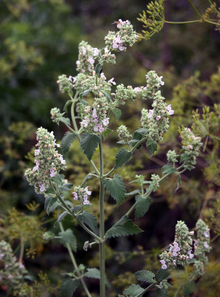This past week, I managed to spy subtle hints of spring. Wild ramps just started to poke out in the woods and robins wandered on the ground, hunting for worms.
As I moved toward my family’s front yard, I saw two plants, close relatives, starting their journey. One, catnip, had a rough start—a patch of green stuck between a concrete sidewalk and a metal drain pipe. The other, catmint, was a pampered landscape plant, nicely mulched and cared for.
My cat, Frodo, made no such distinctions between the two herbs. Both were equally enjoyable to rub up against and occasionally munch on. So why should we care?
Effects on cats
Members of the Nepeta genus, of which both catmint and catnip are a part, are famous for producing nepetalactone. This chemical is structurally similar to certain feline pheromones and serves as an intoxicating treat for many members of the cat family.
The reason these plants evolved this chemical is not known for certain, but it is unlikely nepetalactone was only made for a cat’s enjoyment. Nepetalactone repels certain insect herbivores that could harm Nepeta plants while attracting beneficial ones. Notably, some species of mosquitoes are repelled by the chemical, making it appealing for human use. Cats might even exploit this natural insect repellent in the wild by rubbing against catmint or catnip leaves, a 2021 Japanese study suggested.
Catnip
Catnip (Nepeta cataria) is a perennial plant about two to three feet tall with whitish flowers. Hardy to at least Zone 4, catnip prefers a drained soil with a decent amount of moisture and access to sunshine. The plant has few insect pests, is deer resistant, and is considered an attractive plant for certain pollinators such as honeybees and bumblebees.
This plant is originally from Europe and Asia, where it was long used by humans in cooking as well as in herbal medicine. Nowadays, catnip is grown as an ornamental and commercially for its oils and leaves.
European immigrants likely brought the plant to North America, where it is now considered naturalized. Naturalized means the non-native catnip can reproduce and stick around on its own without people purposely planting it. Currently, catnip is NOT listed as a state noxious weed or regulated plant in Minnesota. Still, some states such as West Virginia consider catnip an invasive species.
The catnip I discovered was essentially a weed, but not a particularly tough one. In previous years I observed catnip being shaded out when pitted against other notorious weeds such as lambsquarters (Chenopodium album).
Indeed, when catnip is grown on farms it often struggles against other weeds. In a 2004 Iowa State University study, weedy catnip plots yielded about half as much as weed-free catnip. In contrast, another herb tested, St. John’s wort (Hypericum perforatum) yielded the same regardless of weed numbers.
Catmints
Unlike catnip, catmints include many species in the Nepeta genus. While there is large-scale cultivation of catmints, in the U.S. they are primarily used in gardening rather than grown for essential oil or cat toys. In general, most garden catmints share catnip traits and preferences for drained soil and full sun. However, size, flower color, zone and other factors could be different from catnip depending on the species and variety.
One of the most popular varieties of catmint, Faasen’s catmint (Nepeta x faassenii) is actually a sterile hybrid of two species—the eastern catmint (Nepeta racemosa) and the lesser catmint (Nepeta nepetella). This catmint has several advantages over catnip and is usually a better choice for landscapes. Since Faasen’s catmint is sterile, there is little risk of weedy spread via seeds (unlike catnip). Due to its popularity, there are several varieties available of Faasen’s catmint. ‘Walker’s Low’ is perhaps the most well-known, and is the variety I suspect was growing in our family’s garden.
Faasen’s catmint enjoys a long bloom time, benefiting pollinators. After its flowers are spent, trimming the blooms back often encourages another flush. In fact, Faasen’s catmint is such a powerful pollinator ally that it is one of the few non-native plants that made the UMN Bee Squad’s list of recommended flowers, attracting both native bees and honeybees.
While my cat may disagree with me, catmint ticks a lot of boxes compared to catnip. Catmints can be an attractive addition to a wide array of landscapes while providing impressive pollinator resources.
Catnip might be more suitable to grow commercially as there is more research for growing it on a larger scale. However, there are significant challenges when growing catnip as a crop and its weedy potential might be too much for gardeners.
Duppong, L. M., Delate, K., Liebman, M., Horton, R., Romero, F., Kraus, G., ... & Chowdbury, P. K. (2004). The effect of natural mulches on crop performance, weed suppression and biochemical constituents of catnip and St. John's wort. Crop science, 44(3), 861-869.
Eisner, T. (1964). Catnip: its raison d'etre. Science, 146(3649), 1318-1320.
Lichman, B. R., Godden, G. T., Hamilton, J. P., Palmer, L., Kamileen, M. O., Zhao, D., ... & O’Connor, S. E. (2020). The evolutionary origins of the cat attractant nepetalactone in catnip. Science Advances, 6(20).
Mahr, S. (2021). Nepeta x faassenii ‘Walker’s Low’. University of Wisconsin Extension.
Park, C. H., Tannous, P., Juliani, H. R., Wu, Q. L., Sciarappa, W. J., VanVranken, R., ... & Simon, J. E. (2007). Catnip as a source of essential oils. Creating markets for economic development of new crops and new uses (ed. Whipkey, A.), 311-315.
Sih, A., & Baltus, M. S. (1987). Patch size, pollinator behavior, and pollinator limitation in catnip. Ecology, 68(6), 1679-1690.
Uenoyama, R., Miyazaki, T., Hurst, J. L., Beynon, R. J., Adachi, M., Murooka, T., ... & Miyazaki, M. (2021). The characteristic response of domestic cats to plant iridoids allows them to gain chemical defense against mosquitoes. Science Advances, 7(4).
West Virginia Department of Natural Resources. (2009). Invasive Plant Species of West Virginia.






